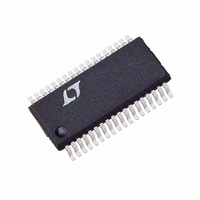LTC1479CG Linear Technology, LTC1479CG Datasheet - Page 13

LTC1479CG
Manufacturer Part Number
LTC1479CG
Description
IC CTRLR DUAL BATT SYS 36-SSOP
Manufacturer
Linear Technology
Datasheet
1.LTC1479CGPBF.pdf
(24 pages)
Specifications of LTC1479CG
Function
Dual Battery Controller
Battery Type
Lead Acid, Li-Ion, NiCd, NiMH
Voltage - Supply
6 V ~ 28 V
Operating Temperature
0°C ~ 70°C
Mounting Type
Surface Mount
Package / Case
36-SSOP (0.200", 5.30mm Width)
Lead Free Status / RoHS Status
Contains lead / RoHS non-compliant
Available stocks
Company
Part Number
Manufacturer
Quantity
Price
Part Number:
LTC1479CG
Manufacturer:
LT
Quantity:
20 000
Part Number:
LTC1479CG#PBF
Manufacturer:
LINEAR/凌特
Quantity:
20 000
APPLICATIONS
In the “3-diode” mode, only the first half of each power
path switch pair, i.e., SW A, SW C and SW E, is turned on;
and the second half, i.e., SW B, SW D and SW F, is turned
off. These three switch pairs now act simply as three
diodes connected to the three main input power sources
as illustrated in Figure 4. The power ‘diode’ with the
highest input voltage passes current through to the input
of the DC/DC converter to ensure that the power manage-
ment P is powered at start-up or under abnormal oper-
ating conditions. (An undervoltage lockout circuit defeats
this mode when the V
4.5V).
“Cold Start” Initial Condition
The LTC1479 is designed to start in the “3- diode” mode
when all five logic inputs are low— when no power is
available (including the backup system). A 100k resistor
from the 3DM input to ground ensures that this input is low
during a “cold start.” This will cause the main PowerPath
switches to pass the highest voltage available to the input
of the DC/DC converter. Normal operation will then
resume after a good power source is identified.
Recovery from Uncertain Power Conditions
The “3-diode” mode can also be asserted (by applying an
active low to the 3DM input) when abnormal conditions
exist in the system, i.e., when all power sources are
deemed not “good” or are depleted, or the management
system P is being reset or not functioning properly. (See
BAT1
BAT2
DCIN
U
ON
+
SW A
INFORMATION
pin drops below approximately
U
SW B
OFF
Figure 4. LTC1479 PowerPath Switches in “3-Diode” Mode
W
ON
SW C
PowerPath CONTROLLER
SW D
U
LTC1479
OFF
ON
SW E
SW F
the Power Management P Interface section for additional
information on when to invoke “3-diode” mode.)
COMPONENT SELECTION
N-Channel Switches
The LTC1479 adaptive inrush limiting circuitry permits the
use of a wide range of logic-level N-channel MOSFET
switches. A number of dual low R
in 8-lead surface mount packages are available that are
well suited for LTC1479 applications.
The maximum allowable drain source voltage, V
of the three main switch pairs, SW A/B, SW C/D and SW
E/F, must be high enough to withstand the maximum DC
supply voltage. If the DC supply is in the 20V to 28V range,
use 30V MOSFET switches. If the DC supply is in the 10V
to 18V range, and is well regulated, then use 20V MOSFET
switches.
As a general rule, select the switch with the lowest R
at the maximum allowable V
dissipated in the switches while increasing the overall
system efficiency. Higher switch resistances can be toler-
ated in some systems with lower current requirements,
but care should be taken to ensure that the power dissi-
pated in the switches is never allowed to rise above the
manufacturer’s recommended levels.
The maximum allowable drain-source voltage, V
of the two charger switch pairs, SW G and SW H, need only
OFF
R
SENSE
C
IN
+
MANAGEMENT
DS
REGULATOR
SWITCHING
EFFICIENCY
POWER
. This will minimize the heat
DC/DC
DS(ON)
HIGH
P
N-channel switches
1479 F04
LTC1479
12V
5V
3.3V
DS(MAX)
DS(MAX)
13
DS(ON)
,
,













